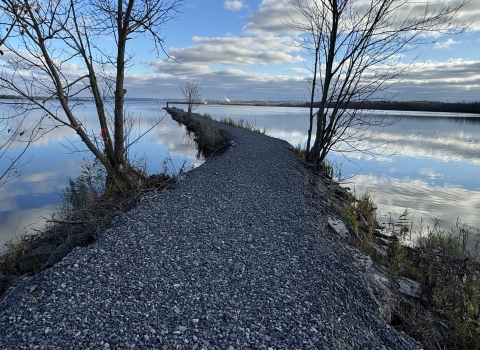For thousands of years, Indigenous people cared for the land under our feet. They nurtured the land as the land nourished the people. But in one of the country’s original acts of environmental injustice, these original caretakers suffered the seizure of their ancestral territory.
The U.S. government now is addressing these acts, and in central New York, a partnership among the Onondaga Nation, the U.S. Fish and Wildlife Service, and the State of New York has fostered the return of more than 1,000 acres of ancestral homeland to the Onondaga Nation.
The U.S. Fish and Wildlife Service recognizes the Onondaga Nation as the rightful caretakers of their homelands. We look forward to continuing our government-to-government relationship with the Nation as they work to heal and preserve these lands and waters for future generations.
Rightful caretakers
Onondaga Lake is sacred to the Onondaga Nation and its people. Haudenosaunee tradition holds that more than 1,000 years ago, the Peacemaker helped form the Haudenosaunee Confederacy by gathering the then-warring five Nations on its shore, where they buried their weapons of war and agreed to govern themselves under the Great Law of Peace.
But for more than a century, from 1881 to 1986, mercury and other hazardous substances were released into Onondaga Lake by nearby industrial facilities. Natural resources such as surface water, sediments and wildlife in the lake, its tributaries and associated wetlands and uplands were adversely affected by these contaminants, as were the Nation and its people.
Through the Service’s Natural Resource Damage Assessment and Restoration program, a 2018 settlement among the U.S. Department of the Interior, the State of New York, Honeywell International Inc, and Onondaga County, New York, outlined specific restoration projects to compensate for the environmental harm, including preservation of 1,023 acres within the Tully Valley of New York. These lands fall within the ancestral territory of the Onondaga Nation.
The Canandaigua Treaty of 1794 was intended to establish peace and friendship between the young United States and the Six Nations of the Haudenosaunee Confederacy, one of which is the Onondaga Nation. The treaty recognized the sovereignty of the Six Nations to self-govern and set laws, as well as affirmed Haudenosaunee land rights. Although the treaty has been violated on numerous occasions, it is still recognized today by the Confederacy and the U.S. Government.
On September 30, thanks to an innovative partnership among the Onondaga Nation, the U.S. Fish and Wildlife Service, and the State of New York — this land at the headwaters of Onondaga Creek is once again under the stewardship of the Nation.
A path forward
According to the Nation, re-establishing stewardship over these lands is a ground-breaking opportunity to restore the acreage, preserve Onondaga culture and address historical and ongoing land injustices.
To restore these lands and waters and preserve them for future generations, Onondaga Nation will develop a Healing and Caretaking Plan that will reflect Traditional Ecological Knowledge and the Onondaga Nation’s cultural, spiritual and educational practices and science. The plan will describe the process for determining the healing, caretaking and stewardship needs of the land; develop appropriate TEK-based healing, caretaking and stewardship goals and methods; and identify opportunities to develop cultural, educational and recreational public uses that are compatible with conservation, restoration and stewardship.
This innovative use of NRDAR funds is about more than repatriating the Nation’s ancestral lands; it’s about respecting Indigenous rights and sovereignty. In returning the land to its original stewards, partnership on restoration efforts will be at the invitation of the Nation.
This important first step in returning the land at the headwaters of Onondaga Creek is small compensation for the troubled 230-year history the Nation shares with the federal and state governments. It’s a start to address the U.S. commitment to honoring the Canandaigua Treaty and the place the Onondaga Nation calls home, one acre at a time.







